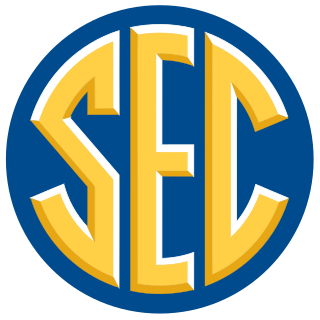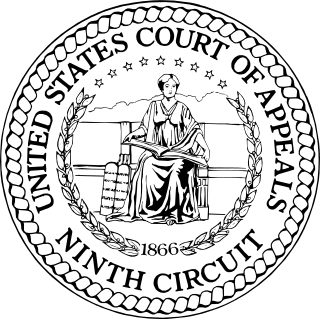
The Sherman Antitrust Act of 1890 is a United States antitrust law which prescribes the rule of free competition among those engaged in commerce. It was passed by Congress and is named for Senator John Sherman, its principal author.

The National Collegiate Athletic Association (NCAA) is a nonprofit organization that regulates student athletics among about 1,100 schools in the United States, and one in Canada. It also organizes the athletic programs of colleges and helps over 500,000 college student athletes who compete annually in college sports. The organization is headquartered in Indianapolis, Indiana.

The Southeastern Conference (SEC) is an American college athletic conference whose member institutions are located primarily in the South Central and Southeastern United States. Its fourteen members include the flagship public universities of ten states, three additional public land-grant universities, and one private research university. The conference is headquartered in Birmingham, Alabama. The SEC participates in the National Collegiate Athletic Association (NCAA) Division I in sports competitions; for football it is part of the Football Bowl Subdivision (FBS), formerly known as Division I-A.

The Big Eight Conference was a National Collegiate Athletic Association (NCAA)-affiliated Division I-A college athletic association that sponsored football. It was formed in January 1907 as the Missouri Valley Intercollegiate Athletic Association (MVIAA) by its charter member schools: the University of Kansas, University of Missouri, University of Nebraska, and Washington University in St. Louis. Additionally, the University of Iowa was an original member of the MVIAA, while maintaining joint membership in the Western Conference.
McLaurin v. Oklahoma State Regents, 339 U.S. 637 (1950), was a United States Supreme Court case that prohibited racial segregation in state supported graduate or professional education. The unanimous decision was delivered on the same day as another case involving similar issues, Sweatt v. Painter.

Gaylord Family Oklahoma Memorial Stadium, also known as Owen Field or The Palace on the Prairie, is the football stadium on the campus of the University of Oklahoma in Norman, Oklahoma. It serves as the home of the Oklahoma Sooners football team. The official seating capacity of the stadium, following renovations before the start of the 2019 season, is 86,112, making it the 22nd largest stadium in the world, the 13th largest college stadium in the United States and the second largest in the Big 12 Conference, behind Darrell K Royal–Texas Memorial Stadium at the University of Texas at Austin.

The Southwest Conference (SWC) was an NCAA Division I college athletic conference in the United States that existed from 1914 to 1996. Composed primarily of schools from Texas, at various times the conference included schools from Oklahoma and Arkansas.
College football on television includes the broad- and cablecasting of college football games, as well as pre- and post-game reports, analysis, and human-interest stories. Within the United States, the college version of American football annually garners high television ratings.
College Football on CBS Sports is the blanket title used for broadcasts of college football games that are produced by CBS Sports, for CBS and CBS Sports Network.

College Football on NBC Sports is the de facto title used for broadcasts of NCAA college football games produced by NBC Sports.
On May 24, 1982, the United States Football League (USFL) reached an agreement with ABC and ESPN on television rights. The money for inaugural 1983 season would be a total of $13 million: $9 million from ABC and $4 million from ESPN.

The Sports Broadcasting Act of 1961 affects Title 15 of the United States Code, Chapter 32 "Telecasting of Professional Sports Contest"
Sipuel v. Board of Regents of the University of Oklahoma, 332 U.S. 631 (1948), is a per curiam United States Supreme Court decision involving racial segregation toward African Americans by the University of Oklahoma and the application of the Fourteenth Amendment to the United States Constitution.
Flood v. Kuhn, 407 U.S. 258 (1972), was a decision by the Supreme Court of the United States that preserved the reserve clause in Major League Baseball (MLB) players' contracts. By a 5–3 margin, the Court reaffirmed the antitrust exemption that had been granted to professional baseball in 1922 under Federal Baseball Club v. National League, and previously affirmed by Toolson v. New York Yankees, Inc. in 1953. While the majority believed that baseball's antitrust exemption was anomalous compared to other professional sports, it held that any changes to the exemption should be made through Congress and not the courts.

ABC first began broadcasting regular season college football games in 1950, and has aired games of the now-National Collegiate Athletic Association (NCAA) Division I Football Bowl Subdivision (FBS) annually since 1966. After the ABC Sports division was merged into ESPN Inc. by parent company Disney in 2006, broadcasts have since been produced by ESPN, and have primarily used the ESPN College Football branding and graphics instead of the College Football on ABC branding.
College Football on TBS was the American presentation of the TBS cable channel's regular season college football television package.
The College Football Association (CFA) was a group formed by many of the American colleges with top-level college football programs in order to negotiate contracts with TV networks to televise football games. It was formed in 1977 by 63 schools from most of the major college football conferences and selected schools whose football programs were independent of any conference.

O'Bannon v. NCAA, 802 F.3d 1049, was an antitrust class action lawsuit filed against the National Collegiate Athletic Association (NCAA). The lawsuit, which former UCLA basketball player Ed O'Bannon filed on behalf of the NCAA's Division I football and men's basketball players, challenges the organization's use of the images and the likeness of its former student athletes for commercial purposes. The suit argues that upon graduation, a former student athlete should become entitled to financial compensation for NCAA's commercial uses of their image. The NCAA maintains that paying its athletes would be a violation of its concept of amateurism in sports. At stake are "billions of dollars in television revenues and licensing fees."
Andrew Montgomery Coats is an American lawyer and politician. He attended the University of Oklahoma. A Democrat, he served as mayor of Oklahoma City, Oklahoma from 1983 to 1987. In 1984, Coats successfully argued the case NCAA v. Board of Regents of the University of Oklahoma before the U.S. Supreme Court, which held that the National Collegiate Athletic Association (NCAA) television plan violated the Sherman and Clayton Antitrust Acts. From 1996 to 2010, he was the Dean of the University of Oklahoma College of Law. He is also a former president of the American College of Trial Lawyers. From 1976 to 1980, he was Oklahoma County District Attorney. In 1980, he unsuccessfully ran in the United States Senate election to replace Henry Bellmon. He was inducted into the Oklahoma Hall of Fame in 2005. His son, Sanford Coats served as United States Attorney for the Western District of Oklahoma from 2009 to 2016. He is the most recent mayor of Oklahoma City to be a Democrat.
National Collegiate Athletic Association v. Alston, 594 U.S. ___ (2021), was a landmark United States Supreme Court case concerning the compensation of collegiate athletes within the National Collegiate Athletic Association (NCAA). It followed from a previous case, O'Bannon v. NCAA, in which it was found that the NCAA was profiting from the namesake and likenesses of college athletes. The case dealt with the NCAA's restrictions on providing college athletes with non-cash compensation for academic-related purposes, such as computers and internships, which the NCAA maintained was to prevent the appearance that the student athletes were being paid to play or treated as professional athletes. Lower courts had ruled that these restrictions were in violation of antitrust law, which the Supreme Court affirmed in a unanimous ruling in June 2021.











